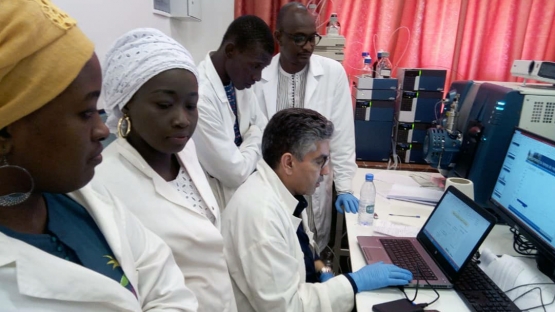Senegal’s authorities can now more quickly, independently and cost-effectively detect residues and contaminants in food products, benefiting the population’s health and the country’s food export competitiveness. The analysis is based on nuclear techniques.
With a four-year project ending this year, the IAEA, in partnership with the Food and Agriculture Organization of the United Nations (FAO), provided training to ten experts at four national laboratories to screen a wide range of residues and contaminants in foods that could cause health risks for consumers. The laboratories received related method-validation protocols and training on analytical measurement uncertainty, proficiency testing and associated data analysis.
“Before our advanced analytical capabilities were established, we were severely hampered and had to send scientists carrying several food samples abroad to laboratories in countries such as Morocco and France to test for food hazards. The outsourcing of analytical tests was cumbersome and time consuming, but the situation has now reversed,” said Assiongbon Teko-Agbo, Head of LACOMEV, the Veterinary Drug Control Laboratory of the Inter-State School of Veterinary Sciences and Medicine of Dakar (EISMV).
Worldwide, veterinary medicines and pesticides are used in food production to control animal and plant diseases and pests. However, residues of these substances along with contaminants such as mycotoxins, biotoxins and toxic metals can present health risks to consumers. Testing ensures that products containing unacceptable levels of hazards are not allowed into the food supply chain.
Through the IAEA technical cooperation programme, state-of-the-art equipment to identify these hazards, including a radio receptor assay and a liquid chromatography tandem mass spectrometer, were delivered along with training on their use. The IAEA also provided laboratory information management systems and consumables.
The radio receptor assay method is easy to use and provides accurate tests for more than 10 groups of veterinary antimicrobial and pesticide residues as well as mycotoxins in milk, meat, eggs, fish, honey, grains and animal feed. Availability of this capacity in Senegal is expected to boost consumer and market confidence and make the country’s exports of agricultural and food products more competitive. The volume of food products analysed for residues and contaminants has increased from 800 to 4000 tons per year since 2017, according to the Laboratory at the National Analysis and Control Laboratory (LANAC).
Besides LACOMEV and LANAC, two other laboratories took part in the project: the Food Technology Institute (ITA) laboratory and the Regional Center for Research on Ecotoxicology and Environmental Safety (Ceres Locustox).






